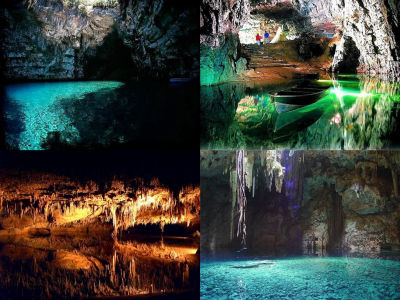The Sahara Desert, the world's largest desert, was once full of greenery

by
The Sahara Desert , which extends to the northeastern part of the African continent, is known as the world's largest desert except for the South Pole, but it seems that the Sahara Desert thousands of years ago had a completely different sight from the 21st century. Fall of Civilizations Podcast , which distributes podcasts explaining the history of civilization, said, `` The Sahara Desert was once covered with greenery, '' and also explains why the Sahara Desert's green was lost The
Today, we know that Sahara Desert as a vast sea of sand and salt flats.But up until around 5,000 years ago, this is how it looked.
— Fall of Civilizations Podcast (@Fall_of_Civ_Pod) September 1, 2019
It was a green landscape of Savannahs, lakes and rivers where early humans lived, hunted and fished.
(???? https://t.co/4dSIryAspu ) pic.twitter.com/OohWf9lXrI
Speaking of the Sahara Desert, most people recall the scene of sand covered in one side, but about 5000 years ago, the land covered with green was spreading. There are many lakes and rivers, and the early humans lived there, hunting and fishing.

by
This is an aerial photograph of the Sahara Desert as of the 21st century. A vast desert spreads out, and the lake that once existed has no shadow or shape.

The era when lakes and rivers existed in Sahara was also expressed as “Green Sahara” (African wet season), and the peak of the wet season was reached 9000 to 6000 years ago. Sahara, which has a gentle grassland, has a sparse forest with acacia trees.
This era is known as the African Humid Period, and it peaked between 9,000 and 6,000 years ago.
— Fall of Civilizations Podcast (@Fall_of_Civ_Pod) September 1, 2019
In those days, the landscape of the Sahara would have supported rolling grasslands, lakes and rivers, as well as sparse forests of trees like acacia.pic.twitter.com/ur6eDvS6bY
It is also clear that the Neolithic people built a community in Sahara. In the central part of the Sahara Desert, which is now a barren land, paintings depicting rocks of many animals and swimming people have been discovered.
It was also home to Neolithic human communities.
— Fall of Civilizations Podcast (@Fall_of_Civ_Pod) September 1, 2019
In fact, rock paintings have been found in the central Sahara that depict abundant animal life, and even people swimming, in places that are today a barren desert.
(???? Dr. Stefan Kröpelin, Köln University) pic.twitter.com/ptFGjVpzpX
Most of the communities that formed the community were hunter-gatherers, but eventually cattle and sheep were bred. People observe the world around them, and the life-size petroglyphs called “Dobous Giraffes” drawn about 11,000 to 7000 years ago are said to be the largest animal petroglyphs in the world.
These communities were largely hunter-gatherers, but were increasingly beginning to practice pastoralism, ie.keeping cows and sheep.
— Fall of Civilizations Podcast (@Fall_of_Civ_Pod) September 1, 2019
Observed The World They Around Them, And Created Incredible Artworks Like The So-Called Dobous Giraffes (Pictured). Pic.Twitter.Com/CpMBm0Ykfy
However, the civilization of “Green Sahara”, which is full of rich nature, will end suddenly. The Earth's precession that occurs approximately every 25,800 years rotates the Earth's axis of rotation, and the Sahara began to dry as the rainfall area moved south of Sahara about 5,000 years ago.
But the days of their societies were numbered.
— Fall of Civilizations Podcast (@Fall_of_Civ_Pod) September 1, 2019
In The Earth Changes'S Orbit Known As Its Orbital Precession, A Change In Tilt That Cycles Every 25,000 Years, Forced The African Monsoon Rains Southward, And The Sahara Became Drier. Pic.Twitter.Com/0RO33CRq0u
First of all, large trees withered, and eventually the grass withered, and the ground surface was blown away by the wind.
Trees and large plants would have died first, until only grass remained.And then even the grass would have withered and died.
— Fall of Civilizations Podcast (@Fall_of_Civ_Pod) September 1, 2019
Roots To Hold Without Together The Earth, The Topsoil Blew Away, And Desertification Set In. Pic.Twitter.Com/s7JJuDksTI
There are several views about how long it took for Sahara to desertify, but some believe that it took only a few hundred years for Sahara to desertify. People who lived in Sahara escaped from desertification and moved to the coast and south to establish a settled society.
While estimates vary wildly, some believe that this process could have taken only a few hundred years.
— Fall of Civilizations Podcast (@Fall_of_Civ_Pod) September 1, 2019
Human societies fled the advance of the desert, moving to the coasts. Their populations concentrated there, and they built settled societies that lived in cities.pic.twitter.com/DfUk1FHSfM
The Sahara Desert is an example that reminds us that changes in the Earth can dramatically change nature and people's lives. “History is a record of change and reminds us that what we think is natural is not so natural,” concluded the Fall of Civilizations Podcast.
The Green Sahara reminds us of the dramatic changes that can arise from even gradual planetary shifts.
— Fall of Civilizations Podcast (@Fall_of_Civ_Pod) September 1, 2019
It reminds us that history is a record of change, and that things we often take for granted are not as certain as we might think.pic.twitter.com/qkW8Z0Y0is
Related Posts:
in Note, Posted by log1h_ik







